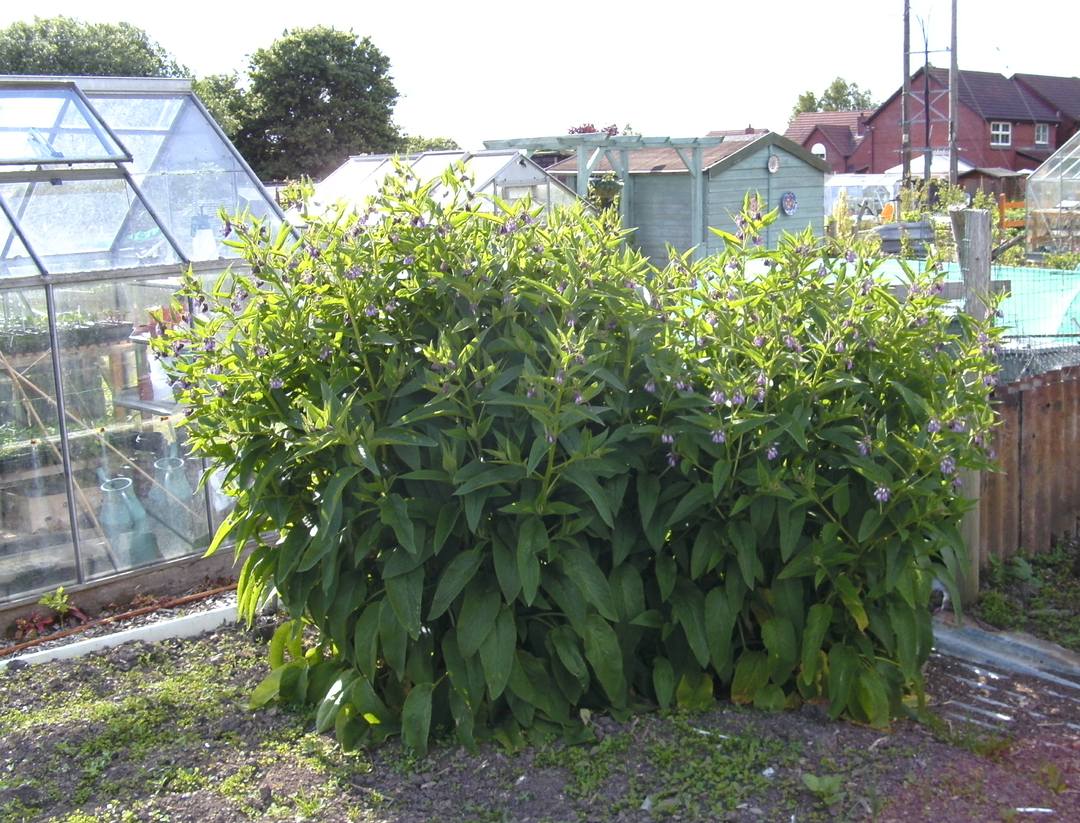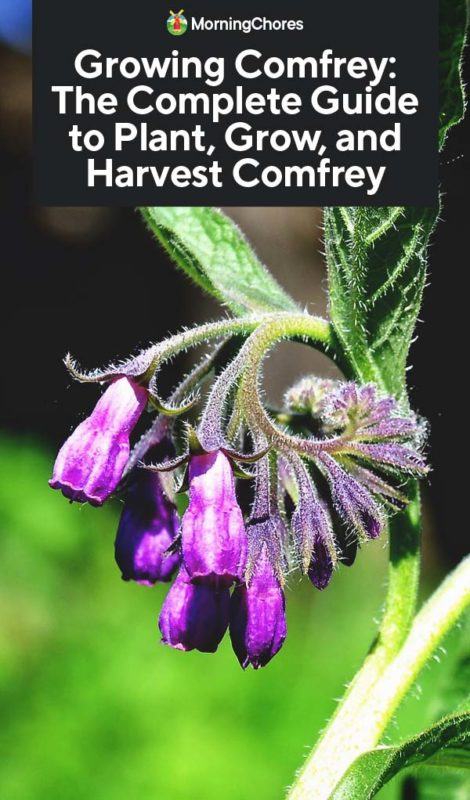To harvest comfrey, cut the leaves and stems close to the ground. Comfrey can be harvested multiple times throughout the growing season, but avoid taking more than a third of the plant at once.
Comfrey, a versatile and valuable herb, is cultivated for its many medicinal and garden uses. Whether you want to use it as a natural fertilizer or for making poultices and ointments, knowing how to harvest comfrey correctly is essential. In this guide, we will discuss the steps you need to take to harvest comfrey effectively.
By following these simple instructions, you can ensure a bountiful harvest of this beneficial plant without causing harm or compromising its growth. So, let’s delve into the process of harvesting comfrey and learn how to do it like a pro.

Credit: www.allotment-garden.org
How to Harvest Comfrey: Step by Step Guide
Preparing For Comfrey Harvesting
Looking for tips on how to harvest comfrey? This quick guide will help you prepare for a successful comfrey harvest, ensuring you get the most out of this versatile herb. Follow these steps for a bountiful yield of comfrey leaves and roots.
To harvest comfrey effectively, it is important to prepare adequately. One crucial step is choosing the right time for harvesting. It is recommended to wait until the comfrey has reached its peak flowering stage before harvesting. This is generally when the plant is about 2-3 feet tall and the flowers are in full bloom. Harvesting at this stage ensures that the comfrey contains the maximum amount of nutrients and medicinal properties.
Another important aspect of preparing for comfrey harvesting is gathering the necessary tools and equipment. You will need a sharp pair of garden shears or scissors to cut the stems, as well as a clean container or basket to collect the harvested comfrey leaves and flowers. It is also a good idea to wear gloves to protect your hands from any potential irritation. By following these steps, you can ensure a successful and fruitful comfrey harvest.
Harvesting Comfrey Leaves
When harvesting comfrey leaves, it is important to select mature plants. Mature comfrey plants have larger leaves and are rich in nutrients. Properly cutting the leaves is crucial to ensure effective harvesting. To do this, you can use scissors or pruning shears to trim the leaves close to the base of the plant. When handling the leaves, it is important to take precautions to avoid irritation.
Wearing gloves and long sleeves can help protect your skin from the tiny hairs on the comfrey leaves, which can cause irritation for some individuals. It is also recommended to wash your hands thoroughly after handling the leaves. By following these guidelines, you can successfully harvest comfrey leaves for various uses, such as making herbal infusions or composting.
Drying And Storing Comfrey
Considering different drying methods: When it comes to harvesting and drying comfrey, there are various methods to choose from. Some popular options include air drying, dehydrator drying, and oven drying. Each method has its advantages and it’s important to select one that suits your needs and preferences.
Maintaining proper airflow during the drying process: One crucial factor in drying comfrey is ensuring proper airflow. This promotes even drying and prevents the growth of mold or mildew. Spread the comfrey leaves in a single layer on a drying rack or screen, making sure there is enough space between the leaves. You can also gently turn the leaves occasionally to ensure all sides dry evenly.
Storing dried comfrey leaves for long-term use: Once the comfrey leaves are fully dried, it’s essential to store them properly to maintain their quality and potency. Store the leaves in airtight containers such as glass jars or resealable bags. Keep them in a cool, dark, and dry place — preferably away from direct sunlight. This will help preserve their medicinal properties for long-term use. Remember to label the containers with the date of drying for easy reference.
Extracting Nutrients From Comfrey
Harvesting comfrey is a great way to extract important nutrients for various uses. One of the ways to do this is by preparing comfrey-infused oil. This process involves infusing comfrey leaves and roots in a carrier oil such as olive oil or coconut oil. The oil can then be used topically for its healing properties.
Another method of extracting nutrients from comfrey is by making a comfrey poultice or salve. This involves mashing comfrey leaves or roots into a paste and applying it directly to the skin. The poultice or salve can help reduce inflammation, heal wounds, and relieve pain.
Additionally, brewing comfrey tea is another way to harness its medicinal benefits. By steeping comfrey leaves in hot water, you can create a soothing tea that can be consumed for its anti-inflammatory properties.
| Benefits of Harvesting Comfrey | |
|---|---|
| Preparing comfrey-infused oil | Extracts healing properties |
| Making comfrey poultice or salve | Reduces inflammation, heals wounds, relieves pain |
| Brewing comfrey tea | Anti-inflammatory, soothing properties |
Safety Precautions And Potential Risks
When harvesting comfrey, it is important to take safety precautions to minimize potential risks. It is recommended to wear protective clothing, including gloves and long sleeves, to avoid direct contact with the plant. Comfrey contains alkaloids that can be toxic if ingested or absorbed through the skin. Avoid inhaling comfrey dust or fumes to prevent respiratory issues.
When handling comfrey, be careful not to expose open cuts or wounds to the plant as it may cause skin irritation or allergic reactions. If accidental contact occurs, wash the affected area immediately with soap and water. It is advisable to work in a well-ventilated area to minimize the risk of inhaling comfrey particles.
While comfrey offers numerous benefits, it is essential to recognize its potential risks and side effects. By following the necessary protective measures, you can safely harvest comfrey for its various uses.
Maintaining And Harvesting Comfrey For Long-term Use
Understanding comfrey’s growth pattern: Comfrey is a perennial herb that grows rapidly and spreads through its extensive root system. It thrives in moist, fertile soil and can tolerate partial shade. Proper soil preparation and older plant maintenance: Before planting comfrey, ensure that the soil is well-drained and rich in organic matter. Clear any weeds or debris from the planting area and loosen the soil with a garden fork or tiller.
Mature comfrey plants should be pruned back regularly to promote new growth and prevent them from becoming woody. Consistent harvesting practices for continuous yield: Comfrey leaves can be harvested multiple times throughout the growing season. To harvest, simply cut the leaves close to the base of the plant. However, it is important to leave enough leaves on the plant to allow for photosynthesis and growth. By consistently harvesting comfrey, you can ensure a steady supply of leaves for various herbal uses.
Frequently Asked Questions On How To Harvest Comfrey
How Do You Harvest Comfrey Leaves?
To harvest comfrey leaves, simply cut the stalks at the base, leaving at least two-thirds of the plant intact. Harvesting can be done multiple times during the growing season, but it’s recommended to harvest just before the plant blooms to ensure high nutrient content.
When Is The Best Time To Harvest Comfrey?
The best time to harvest comfrey is in the morning when the leaves are fully dry. This helps to preserve the medicinal properties of the plant. Avoid harvesting comfrey during or after rainfall as the leaves can become wilted and lose their potency.
Can You Harvest The Comfrey Root?
Yes, the comfrey root can be harvested for its medicinal properties. To harvest the root, dig around the base of the plant and gently lift it out of the ground. Clean the root, remove any soil, and allow it to dry before use.
How Long Does It Take For Comfrey To Regrow After Harvesting?
Comfrey is a fast-growing plant and will regrow quickly after harvesting. Depending on growing conditions, new growth can be seen in as little as two weeks. Regular harvesting actually helps stimulate the growth of new leaves and can result in a healthier plant overall.
Conclusion
Harvesting comfrey is a simple and rewarding process. By following the tips and techniques mentioned you can ensure a successful harvest of this versatile and beneficial herb. Remember to wear gloves and use sharp tools to efficiently gather the leaves.
Proper drying and storage will preserve the potency of comfrey for various uses in DIY remedies and garden fertilizers. Happy harvesting!

